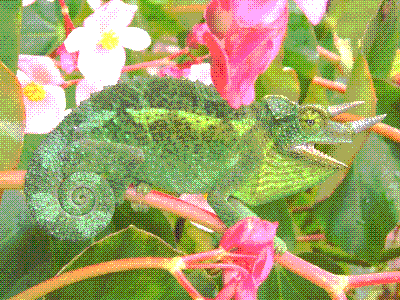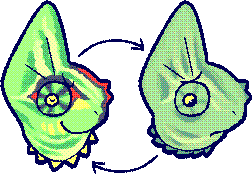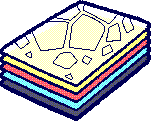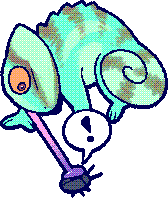


CHAMELEON
Chameleons (Chamaeleonidae) are a family of highly specialized lizards that live predominantly within the rainforests and deserts of Africa. They are mostly known for their ability to change colours in order to camouflage with their environment as well as display emotion. Chameleons are specialized to be arboreal, with fused toes, a prehensile tail, and eyes which move independently of one another.

- Class Reptilia
- Diet Insectivore
- Length 2.2-65 cm (0.9-25.6in)
- Weight 0.006-600g (0.0002-21oz)
- Status Variable
- Environment Rainforests, woodlands, shrublands, savannas, deserts
- Health 40/150
- Attack 120/150
- Defense 40/150
- Speed 1/150
- Abilities Colour changing, projectile tongue, independently moving eyes
- Weaknesses Birds, snakes


Chameleons are a family of strange-looking lizards comprised of ~200+ species. Chameleons live in the rainforests and deserts of Africa, and nearly half of all chameleon species live in Madagascar specifically. They range in size quite a bit, anywhere from 21 millimetres up to 70 centimetres. They're primarily known for their ability to shift colours and for their camouflaging ability. While some chameleons can shift a lot of colours, between pinks, reds, oranges, yellows, greens, turquoises, blues, purples, blacks, and browns, others can only shift slightly between different shades of colours. Chameleons are highly specialized to an arboreal lifestyle, with syndactyl feet (feet with fused toes), prehensile tails, and highly tuned vision. They're also insectivores, and particularly well-adapted to hunting invertebrates, potentially the most well-adapted of any reptile!

Chameleons are known for their ability to change colours. While this is commonly associated with camouflage, a lot of chameleon colour change is actually not for camouflaging purposes! They change colour and pattern for a variety of reasons, based mainly off of hormones, emotion, temperature, light, and other factors. Their colours are predominantly used as a form of social signalling, and provide vital information on health and behaviour to other chameleons. Chameleons will become brighter in response to excitement or to show aggression, and become duller when relaxed or to show submission. This doesn't mean they don't change colour to camouflage at all, though. Their colours at rest will typically reflect the colours of their environment. Chameleons living in places with more predators will change colours a lot less dramatically than those that live in places with few predators. Some species even adjust colours depending on the vision of their native predator species.
Chameleons have a transparent outer layer of skin, and below have several types of cells that help them change their colour. These cells are called chromatophores. The deepest layer contains melanophores, which are cells that contain melanin. Melanin is a form of pigment that makes black and brown colours, and is also the primary pigment that controls human skin tone! By concentrating  and moving melanophores upward, chameleons can change their colours to become darker, and by dispersing melanophores and moving them downward, chameleons can become lighter and brighter. Atop the layer of melanophores are cells called iridophores, which are cells that contain nanocrystal structures that reflect light depending on how densely packed they are. Tightly packed iridophores reflect blue colours, while looser packed iridophores don't. Above the melanophores and iridophores are two other kinds of chromatophores, those being xanthophores and erythrophores. Xanthophores contain yellow pigments, whilst erythrophores contain red pigments. At rest, the pigments within these cells are stored within sacs, making them not visible. However, when expanded, the pigments become visible and the colours within will show. It's similar to inflating a white balloon with a pigment inside, when deflated it looks white, but once expanded the balloon will become more transparent and the colour inside will become visible! In addition, chameleons have blue fluorescent bumps on their skulls, which are visible to humans under UV light!
and moving melanophores upward, chameleons can change their colours to become darker, and by dispersing melanophores and moving them downward, chameleons can become lighter and brighter. Atop the layer of melanophores are cells called iridophores, which are cells that contain nanocrystal structures that reflect light depending on how densely packed they are. Tightly packed iridophores reflect blue colours, while looser packed iridophores don't. Above the melanophores and iridophores are two other kinds of chromatophores, those being xanthophores and erythrophores. Xanthophores contain yellow pigments, whilst erythrophores contain red pigments. At rest, the pigments within these cells are stored within sacs, making them not visible. However, when expanded, the pigments become visible and the colours within will show. It's similar to inflating a white balloon with a pigment inside, when deflated it looks white, but once expanded the balloon will become more transparent and the colour inside will become visible! In addition, chameleons have blue fluorescent bumps on their skulls, which are visible to humans under UV light!

Chameleon tongues are vital for prey capture, and some of the most fascinating structures in nature. Being relatively slow-moving creatures, they utilize a complex ballistic projectile system in order to capture their prey. The chameleon tongue is comprised of three parts: the retractor muscles, the accelerator muscles, and the sticky tip. The tip of the tongue has an abraisive texture and is covered with an incredibly sticky saliva, 400x more viscous than human saliva. It also sports a flap of skin at the end, which wraps around prey when captured. The tongue is held to the back of the mouth using a modified u-shaped hyoid bone, with a cartiligeanous projection called the hyoid horn. The tongue is hollow, made of a stretchy collagen tissue covered in muscle that sheaths over the hyoid horn. When prey is spotted, the chameleon aims, moves it's whole tongue  to the front of it's mouth, and contracts the accelerator muscles on it's tongue. These muscles squeeze around the hyoid horn, compacting the collagen tissue into very tight coils and storing kinetic energy. As the accelerator muscles reach the end of the tapered hyoid bone, they suddenly fire off all at once. A lubricated space between the muscle and bone reduce friction, increasing speed and allowing the tongue to "slip". The firing is similar to squeezing a wet soap bar in your fist! The tongue is so powerful it can reach full extension in as little as 1/16th of a second, with forces exceeding 41 g. To control the length of the strike, a tendon attached to the hyoid bone is used. It activates the retractor muscles, which are folded along the top of the hyoid horn like an accordion. It crumples itself back up after the strike, dragging the tongue and its prey with it.
to the front of it's mouth, and contracts the accelerator muscles on it's tongue. These muscles squeeze around the hyoid horn, compacting the collagen tissue into very tight coils and storing kinetic energy. As the accelerator muscles reach the end of the tapered hyoid bone, they suddenly fire off all at once. A lubricated space between the muscle and bone reduce friction, increasing speed and allowing the tongue to "slip". The firing is similar to squeezing a wet soap bar in your fist! The tongue is so powerful it can reach full extension in as little as 1/16th of a second, with forces exceeding 41 g. To control the length of the strike, a tendon attached to the hyoid bone is used. It activates the retractor muscles, which are folded along the top of the hyoid horn like an accordion. It crumples itself back up after the strike, dragging the tongue and its prey with it.

Chameleons also have excellent vision. Their eyelids are fused together, creating a sort of pinhole only wide enough for their pupils. Each eye protrudes significantly and can see 180° around, giving them a 360° field of vision around their bodies. Each eye can also pivot and focus independently, allowing them to observe two things independently. They can see both visible and UV light, and also have the highest density of cones in their retinas of any vertebrate. While they can see colours very well, they cannot see much contrast, which makes it difficult for them to see in darkness. Luckily they are diurnal, so this does not affect them very much.
Chameleons have heads covered in bony bumps called tubercles, as well as several head crests known as the lateral, parietal, and temporal crests. The lateral crest is the most prominent, and changes a lot in size and shape depending on species. Some chameleons, such as the crested chameleon, even have protruding crests along their spines, though most only have a row of spines to break up their outline. Other chameleons have full-on horns, such as those under the genus Trioceros. They use these horns in combat with other males, in order to shove them off of treetops.
- Sources and Attributions
- - IMAGE: Movingsaletoday edited by Muhammad, Public domain, via Wikimedia Commons
- - Brau, Fabian, et al. “Dynamics of Prey Prehension by Chameleons through Viscous Adhesion.” Nature News, Nature Publishing Group, 20 June 2016, www.nature.com/articles/nphys3795.
- - Jurassosaurus. “Tongue Mechanics.” The Reptipage: Chameleon Tongues, reptilis.net/lacertilia/chamaeleonidae/tongue.html. Accessed 9 May 2025.
- - Slip of the Chameleon’s Tongue | Science | AAAS, www.science.org/content/article/slip-chameleons-tongue. Accessed 9 May 2025.
- - Wikipedia contributors. "Chameleon vision." Wikipedia, The Free Encyclopedia. Wikipedia, The Free Encyclopedia, 15 Oct. 2024. Fri. 9 May. 2025.
- - Wikipedia contributors. "Chameleon." Wikipedia, The Free Encyclopedia. Wikipedia, The Free Encyclopedia, 14 Apr. 2025. Fri. 9 May. 2025.
- - Wikipedia contributors. "Projectile use by non-human organisms." Wikipedia, The Free Encyclopedia. Wikipedia, The Free Encyclopedia, 18 Mar. 2025. Fri. 9 May. 2025.
- - “Chameleons Launch ‘Ballistic’ Tongues - Biological Strategy - Asknature.” AskNature Chameleons Launch Ballistic Tongues Comments, asknature.org/strategy/chameleons-launch-ballistic-tongues/. Accessed 9 May 2025.
- - “The Chameleon Eye.” Madcham.De, 12 Sept. 2014, www.madcham.de/en/das-chamaeleon-auge/. Vitt, Laurie. "chameleon". Encyclopedia Britannica, 26 Apr. 2025, https://www.britannica.com/animal/chameleon-reptile. Accessed 9 May 2025.
- - My awesome fucking brain

